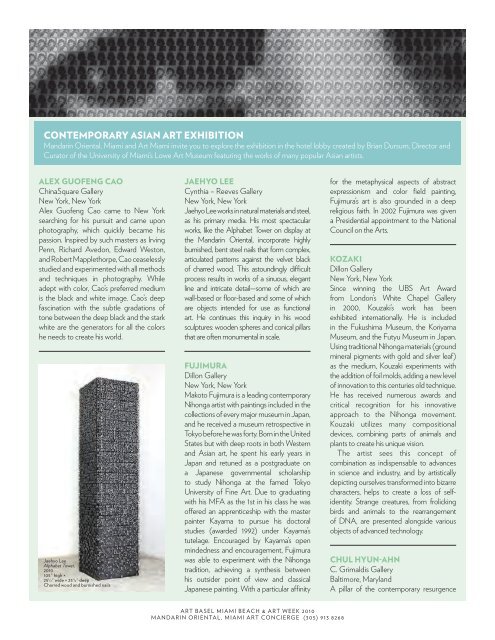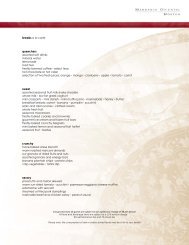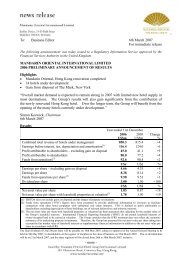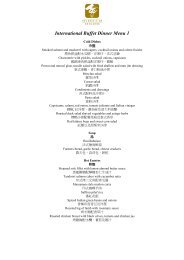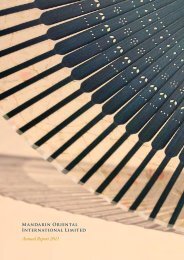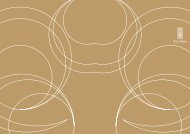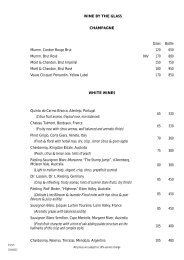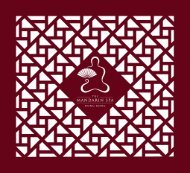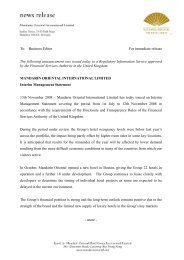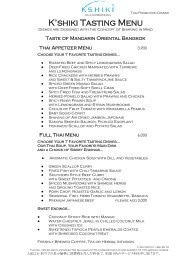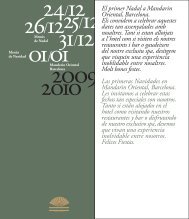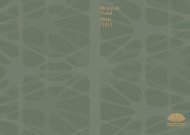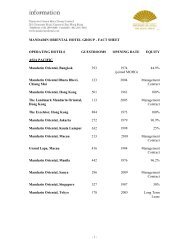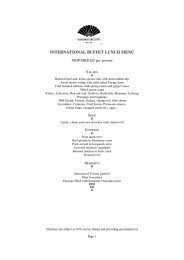art Basel MiaMi Beach & art weeK 2010 November 29 – December ...
art Basel MiaMi Beach & art weeK 2010 November 29 – December ...
art Basel MiaMi Beach & art weeK 2010 November 29 – December ...
Create successful ePaper yourself
Turn your PDF publications into a flip-book with our unique Google optimized e-Paper software.
conteMporary asian <strong>art</strong> exhiBition<br />
Mandarin Oriental, Miami and Art Miami invite you to explore the exhibition in the hotel lobby created by Brian Dursum, Director and<br />
Curator of the University of Miami’s Lowe Art Museum featuring the works of many popular Asian <strong>art</strong>ists.<br />
alex guofeng cao<br />
ChinaSquare Gallery<br />
New York, New York<br />
Alex Guofeng Cao came to New York<br />
searching for his pursuit and came upon<br />
photography, which quickly became his<br />
passion. Inspired by such masters as Irving<br />
Penn, Richard Avedon, Edward Weston,<br />
and Robert Mapplethorpe, Cao ceaselessly<br />
studied and experimented with all methods<br />
and techniques in photography. While<br />
adept with color, Cao’s preferred medium<br />
is the black and white image. Cao’s deep<br />
fascination with the subtle gradations of<br />
tone between the deep black and the stark<br />
white are the generators for all the colors<br />
he needs to create his world.<br />
jaehyo lee<br />
Alphabet Tower,<br />
<strong>2010</strong><br />
105˝ high ×<br />
25 1/ 2˝ wide × 25 1/ 2˝ deep<br />
charred wood and burnished nails<br />
Jaehyo lee<br />
Cynthia <strong>–</strong> Reeves Gallery<br />
New York, New York<br />
Jaehyo Lee works in natural materials and steel,<br />
as his primary media. His most spectacular<br />
works, like the Alphabet Tower on display at<br />
the Mandarin Oriental, incorporate highly<br />
burnished, bent steel nails that form complex,<br />
<strong>art</strong>iculated patterns against the velvet black<br />
of charred wood. This astoundingly difficult<br />
process results in works of a sinuous, elegant<br />
line and intricate detail—some of which are<br />
wall-based or floor-based and some of which<br />
are objects intended for use as functional<br />
<strong>art</strong>. He continues this inquiry in his wood<br />
sculptures: wooden spheres and conical pillars<br />
that are often monumental in scale.<br />
fuJiMura<br />
Dillon Gallery<br />
New York, New York<br />
Makoto Fujimura is a leading contemporary<br />
Nihonga <strong>art</strong>ist with paintings included in the<br />
collections of every major museum in Japan,<br />
and he received a museum retrospective in<br />
Tokyo before he was forty. Born in the United<br />
States but with deep roots in both Western<br />
and Asian <strong>art</strong>, he spent his early years in<br />
Japan and retuned as a postgraduate on<br />
a Japanese governmental scholarship<br />
to study Nihonga at the famed Tokyo<br />
University of Fine Art. Due to graduating<br />
with his MFA as the 1st in his class he was<br />
offered an apprenticeship with the master<br />
painter Kayama to pursue his doctoral<br />
studies (awarded 1992) under Kayama’s<br />
tutelage. Encouraged by Kayama’s open<br />
mindedness and encouragement, Fujimura<br />
was able to experiment with the Nihonga<br />
tradition, achieving a synthesis between<br />
his outsider point of view and classical<br />
Japanese painting. With a p<strong>art</strong>icular affinity<br />
a r t b a s el m i a m i b e ac h & a r t w eek 2 0 1 0<br />
m a n da r i n O r i en ta l , m i a m i a r t cO n c i erg e (3 0 5) 9 1 3 8 2 6 8<br />
for the metaphysical aspects of abstract<br />
expressionism and color field painting,<br />
Fujimura’s <strong>art</strong> is also grounded in a deep<br />
religious faith. In 2002 Fujimura was given<br />
a Presidential appointment to the National<br />
Council on the Arts.<br />
KozaKi<br />
Dillon Gallery<br />
New York, New York<br />
Since winning the UBS Art Award<br />
from London’s White Chapel Gallery<br />
in 2000, Kouzaki’s work has been<br />
exhibited internationally. He is included<br />
in the Fukushima Museum, the Koriyama<br />
Museum, and the Futyu Museum in Japan.<br />
Using traditional Nihonga materials (ground<br />
mineral pigments with gold and silver leaf)<br />
as the medium, Kouzaki experiments with<br />
the addition of foil molds, adding a new level<br />
of innovation to this centuries old technique.<br />
He has received numerous awards and<br />
critical recognition for his innovative<br />
approach to the Nihonga movement.<br />
Kouzaki utilizes many compositional<br />
devices, combining p<strong>art</strong>s of animals and<br />
plants to create his unique vision.<br />
The <strong>art</strong>ist sees this concept of<br />
combination as indispensable to advances<br />
in science and industry, and by <strong>art</strong>istically<br />
depicting ourselves transformed into bizarre<br />
characters, helps to create a loss of selfidentity.<br />
Strange creatures, from frolicking<br />
birds and animals to the rearrangement<br />
of DNA, are presented alongside various<br />
objects of advanced technology.<br />
chul hyun-ahn<br />
C. Grimaldis Gallery<br />
Baltimore, Maryland<br />
A pillar of the contemporary resurgence


